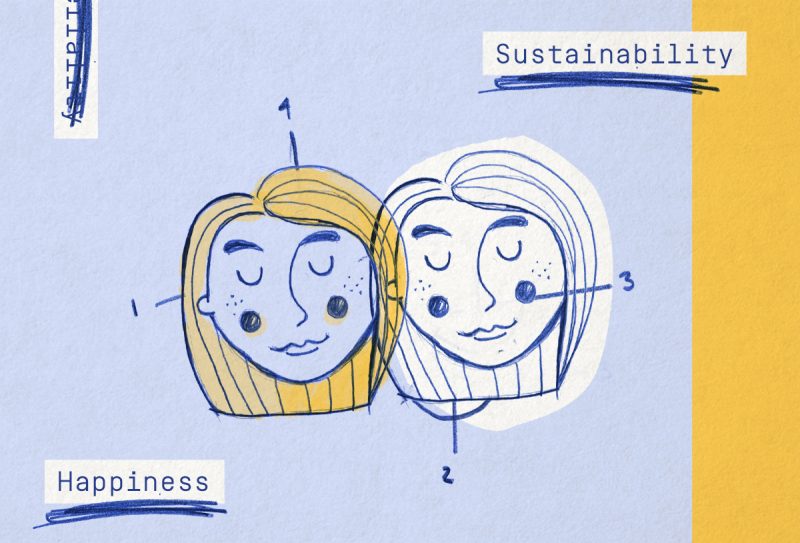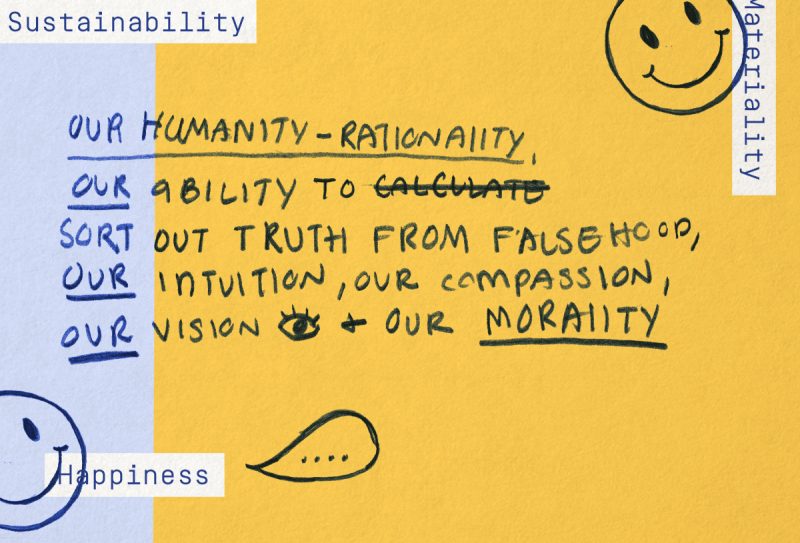Happiness, Materiality & Sustainability.
Posted on November 18, 2016“Living successfully in a world of systems requires more of us than our ability to calculate. It requires our full humanity-our rationality, our ability to sort out truth from falsehood, our intuition, our compassion, our vision, and our morality.” – Donella Meadows(1)

In documentary film “Happy”, people were interviewed and asked what they wanted in life(2). The two most common responses: “to be happy”, and “to be successful”. Is it possible however that these two things mean the same thing – or does the significance of one take us away from the other, and in that case can they both be achieved? “Living successfully”, can be said to look different depending on who is asked the question, varying on whatever definition “success” holds in our heads. While the answer may look drastically different for everyone, there is a conceivably unifying element that could serve as a guide for all.
Perhaps it’s easier to start, by what our governing entities have voiced as the defining measurement of success. For most countries, this means the GDP, a measurement of economic growth that bases a country’s success on its acquired income. One quick look at this concept however quickly reveals a caveat, a myriad of problems and protests felt by citizens that persevere notwithstanding the state of the GDP, revealing in turn the tenuous grip of the GDP on its citizens well-being. This is not to say that there aren’t monetary successful citizens within a GDP oriented system, it is more to highlight that despite citizens monetary success, there is a level of discontent that continues to persists.

In response to this, governments and institutions have been switching the income and GDP measurement of success, to one that is based on “happiness” and an egalitarian approach. A movement that has been seen in the governments of countries like Denmark and Bhutan, as well as with the adoption of “happiness” as part of the United Nations Global Development Goals(3). In all three cases, “success” has stepped away from a connection to materiality to a space that speaks to core human values. This isn’t to say that economic development was simply tossed aside, more so it was retrofitted with “happiness” using a holistic approach. This approach has a name, “sustainability”. While the term’s meaning has been coined and altered to fit a growing list of users. Sustainability has its basis in the United Nation’s Brundtland Commission, who articulated and grouped ideas that had been developing for years. Stating that sustainability is “economic-development activity that meets the needs of the present without compromising the ability of future generations to meet their own needs.” Then, “describing sustainability as having three co-equal parts: environment, economy, and equity”(4)
It is within equity perhaps, where the most drastic contrast to GDP can be found. For GDP is a format merely striving for efficiency and economic growth, in turn putting in the back-burner the elemental human values of well-being. While happiness does not particularly equal equity, it is an encompassing view that houses within it not just equity, but empathy, community, compassion and intrinsic goals(5). Goals that are essential for happiness in all humans, and while they may look different from person to person, for they must be true to the core of each individual, “happiness” is the overarching common goal of humanity. It is “the way out” of “the policy resistance trap” that Donella Meadows talks about(6). Resulting in a palimpsest of success vs. happiness that becomes redefined through the semiotic of what “success” means. For it is perhaps that the aim of success should always be pointing to “happiness”.
- Donella Meadows in the last chapter of her book “Thinking in Systems” explains the importance of being in touch with our humanity and everything it represents.
- Documentary Film “Happy”, directed by Roko Belic. A film that explores happiness, what it means and the ways in which we can achieve it.
- Timothy W. Ryback wrote an article for The New York Times titled “The U.N. Happiness Project”, focused on the U.N. placing “happiness” as part of their global agenda, “recognizing that the GDP […] does not adequately reflect the happiness and well-being of people”. – nytimes.com/2012/03/29/opinion/the-un-happiness-project.html?_r=0
- In Kent E. Portney’s book “Sustainability” for the MIT press, he defines and explores the concept of Sustainability, tracing its origins to the UN Brundtland Commission and the work of Thomas Malthus.
- Tim Kasser, Ph.D professor of psychology for Knox College, explains the difference between intrinsic and extrinsic goals in documentary film “Happy”. — Intrinsic goals are: personal growth, close connected relationships, feelings of community (desire to help). These are the direct opposite of extrinsic goals: financial success, image & status.
- Donella Meadows in her book “Thinking in Systems” argues that the way out of a policy resistant trap is to “let go. Bring in all the actors and […] redefining larger and more important goals that everyone can pull toward together.”
Dani V. Sánchez